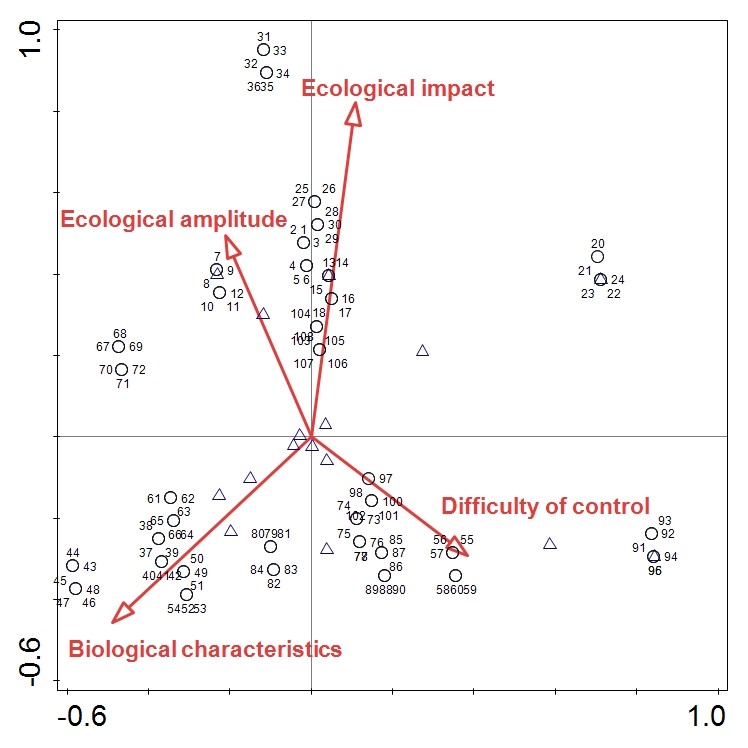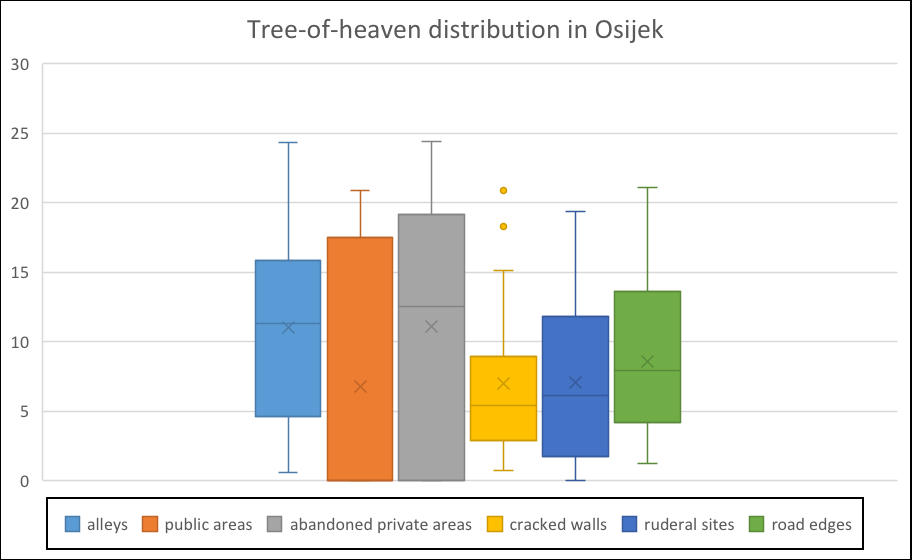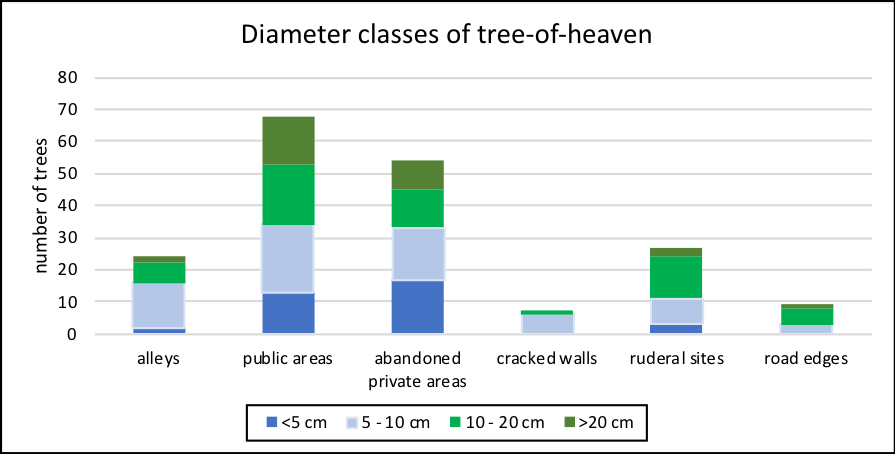1. INTRODUCTION
Tree-of-heaven (Ailanthus altissima (Mill.) Swingle) is an invasive, nonnative species, member of Simaroubaceae family. It is a fast-growing deciduous tree originating from north and central China, Taiwan and North Korea (Nava, 2014). Tree-of-heaven represents one of the worst plant invaders globally, with negative impact on the environment by altering the local vegetation structure and compromising the ecosystem stability (Vila et al., 2010;Sladonja et al., 2015).
Tree-of-heaven was introduced in Europe 1740 as an ornamental plant, and nowadays occupied various habitats such as managed grasslands, natural grasslands, managed forests, natural forests, riverbanks and canal sides (Boer, 2012). Moreover, it is also known for its fast occupation of highly disturbed sites: along roadways, in parks, alleys and even through cracked walls and roofs (Call and Nilsen, 2003). According toPysek et al. (2009) tree-of-heaven is one of the leading invasive woody plants causing a serious damage to the infrastructure and public services utilities in Europe, and was recently added to the list of invasive alien species of European Union (European commission, 2019).
Due to phenotypic plasticity, tree-of-heaven can adopt to various temperatures, humidity, and moisture levels (Granata et al., 2020). This tree also tolerates poor soil conditions, like acid compacted and with low nutrient level (Evans et al., 2006). It also tolerates flood and drought, air pollution (Rank, 1997) and is also an efficient photosynthesizer (Marek, 1988). Tree-of-heaven has a high germination rate, and can easily compete with native species. For example, Kok et al. (2008) in their study in Virginia, presented 17 tree species that may be replaced by large monospecific stands of tree-of-heaven.
It has been reported a significant economic and ecological impact of tree-of-heaven in many urban areas (Lawrence et al., 1991;Kowarik and Sãumel, 2007;Celest-Grapow and Blasi, 2004). Harmfulness of this plant can be observed through different functional, environmental, health and safety and aesthetic types of damage. Therefore, the purpose of this study was to establish baseline distribution and densities and invasiveness ranking of tree-of-heaven along the city streets. This may help to determine management tools and control measures in order to minimize the impact and spread along the leading edges of invasion.
2. MATERIAL AND METHODS
This study was carried out in the city of Osijek (45°33’20’’N; 18°41’40’É) a largest city of the eastern Croatian region Slavonia (Figure 1). Osijek is located on the right bank of the Drava river, at an elevation of 94 m. The city covers 174.85 km2 with a population of 96.848 inhabitants (https:// www.osijek.hr). Osijek is well known for its parks, avenues and green areas which spread on about 300.000 m2 of total city surface (Gucunski, 1968). The climate is humid continental (Köppen classification Dfb;Geiger, 1954), with cold winters and warm summers.

Source: https://gis.osijek.hr/gis?c=2081266%2C5708683&so=&z=14.0 and authors
A survey was performed in all 7 city districts (Retfala, Gornji grad, Industrijska četvrt, Tvrđa, Novi grad, Jug II, and Donji grad) from May to September 2022, by sampling randomly selected 20 quadrats in each city district, having together 140 phytocoenological records. The size of the sample plot was 10 x 10 m, or 100m2 of total area. Presence-absence of tree-of heaven was recorded in each plot. Where present, the number of threes were recorded and the diameter approximately categorized at breast height (dbh) as: large (diameter >20 cm), medium (diameter 10-20 cm), small (diameter 5-10 cm), and very small (diameter <5 cm). Occurrences of tree-of-heaven including both solitary plants and developed stands were recorded in each habitat type. Urban habitats were distinguished as follows: alleys, abandoned private areas, public areas, ruderal sites, cracked walls and road edges.
Risk assessment analysis were prepared according to the template USDA Non-native plant invasive ranking form (Heibert and Stubbendieck, 1993), by combining quantitative (number of trees per plots) and qualitative (questions to be answered in four categories: biological characteristics and dispersal abilities, ecological amplitude and distribution, ecological impact, and difficulty to control) data. CANOCO 5 for windows (Ter Braak and Smilauer, 2012) were used for direct gradient analysis. A unimodal canonical correspondence analysis (CCA) was performed to study relationship between predictor variable (environmental categories) and response variable (tree-of-heaven abundance). The analysis was performed on square-root abundance data at 999 permutations.
3. RESULTS AND DISCUSSIONS
3. 1 Distribution, abundance and size
The collected data indicated that tree-of -heaven is growing in almost all urban areas (Figure 1,Figure 2 A and B). It was frequently found as isolated single tree as well as in clusters in all urban habitats in the city. We recorded a total of 189 tree-of-heaven within 140 sample plots.

Photo source: E. Stefanic
The habitat types with the highest rate of tree-of-heaven are abandoned private areas (34%) followed by public areas (31%), while ruderal sites have 14% and alleys 13%. Distribution of tree-of-heaven on road edges and cracked walls is 5% and 4%, respectively (Figure 3). Our results confirm that tree-of-heaven competes well against other plant species, and grows rapidly in urban environments. Several other studies also explain that tree-of-heaven can successfully establish in urban sites where other species could not grow, for instance, it can be found to germinate in highly compacted soils (Rabe, 1985), spread along roadways (Marsh, 2005) or even emerge in cracks of pavement (Thomson and Neal, 1989).
Significant distribution of tree-of-heaven in public and private areas in Osijek implicate that management measures fail to remove this alien plant species from our urban environment. Literature study offer several explanations for such situation: i) this weedy species is attractive and ornamental, so people kept these trees despite their negative attributes; ii) significant distribution in private properties, often abandoned, make removal effort complicated; iii) general indifference among citizens make managing tree-of-heaven difficult (Kowarik et al. 2021;Todd, 2014).
Of the total recorded 189 trees, 24% have diameter less than 5 cm, 36% were 5-10 cm in diameter, 30% were 10-20 cm in diameter, and 11% were more than 20 cm in diameter. Regarding their presence, 55% of the recorded tree-of-heaven are young individuals belonging to the very small (<5 cm) and small (5-10 cm) diameter classes. This finding points that those individuals were develop from adventitious shoots or were emerged spontaneously from seeds, indicating spread of tree-of-heaven population in Osijek environment. Similar results were obtained in Bari, Italy, where most of the tree-of-heaven population were with diameter less than 20 cm (Castella and Vurro, 2013). The other 45% of registered trees are adult individuals which are capable to produce and disperse winged schizocarp seeds. Tree-of-heaven seeds can stay dormant less than a year, meaning that seed bank is not persistent (Hunter, 2000). Another, more common way of regeneration of this plant invader is sprouting. According toMiller (1990), root sprouts can appear 1,5 to 2,5 m from the mother stem.
On abandoned private and public areas there were present 85% of total young seedlings with less than 5 cm in diameter (Figure 4). Young individuals belonging to the 5-10 cm diameter classes dominate in public areas (31%), followed by abandoned private areas and alleys with 24% and 21% respectively. There were 34% of trees with 10-20 cm in diameter found on public areas, and 21% on abandoned private plots. Individuals with diameter larger than 20 cm grows on public areas (50%), followed by abandoned private areas (30%).
Similar results, presented in many studies, indicate that tree-of-heaven, usually with 1-2 trees and many juveniles, is found in small stands mostly on abandoned urban (private and/or public areas) and roadway sides (Fotiadis et al., 2011;Ulus at al., 2021). Cities and roads are, according toSladonja et al., (2015), a main habitats and corridors for spreading this invasive species.
Invasive character of tree-of-heaven, evaluated by multivariate analysis (Table 1) showed significance of all main criteria. The first two canonical variables explained 73% of total variance in tree-of-heaven risk assessment. The biplot score of explanatory variables, when examined singly, indicated that ecological impact and biological characteristics (with the longest vectors) are the most significant criteria for tree-of-heaven risk assessment (Figure 5).
Source: Authors

Source: Authors
Ecological impact, like loss of biodiversity, habitats alternation and habitat degradation represent the most important criteria for successful invasiveness of tree-of-heaven. After completing statistical comparisons in this criteria in ranking form, the highest score has its following attributes: ability to tolerate a wide range of environmental conditions, history of invasive behavior elsewhere and reduction of biodiversity, especially in urban environments. During monitoring process and study of prevalence and invasiveness of tree-of-heaven in many other urban or rural environment those characteristics are isolated as the most important in spreading of this tree at an alarming rate (Casella and Vurro, 2013;Sladonja et al., (2015).
Biological attributes of tree-of-heaven included the highest score for vegetative reproduction, consistent and prolific yearly seed production, good dispersal, easy germination and establishment as well as short juvenile period.
Spreading and the naturalization of this plant should be prevented and removed from the urban, city environment. There are many alarming reports that once establish, removing it plant from the area requires a very laborious, costly and time-consuming effort (Brundu, 2017).
4. CONCLUSION
Tree-of-heaven (Ailanthus altissima (Mill.) Swingle) is an invasive weedy species that can be found throughout the city of Osijek. Its prevalence in all city parts and all urban habitats make it formidable threat to biodiversity in Osijek’s environment. Tree-of-heaven, occurs both as solitary plants or in developed stands in each city district. The habitat types with the highest rate of tree-of-heaven are abandoned private areas (34%) followed by public areas (31%). Out of the total, 55% of the recorded tree-of heaven are young individuals belonging to the very small and small diameter classes, and are mainly present on abandoned private and public areas. Ecological impact and biological characteristics of tree-of-heaven are primary course of its landscape spread.


